(完整word版)高一英语教学案例分析
新外研版高一英语教案:必修1 Unit 1 1.3 Developing ideas 教学设计(1) Word版含答案
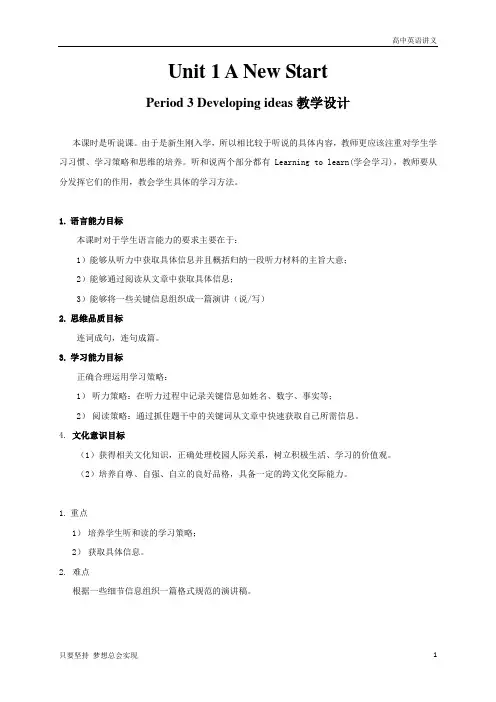
Unit 1 A New StartPeriod 3 Developing ideas教学设计本课时是听说课。
由于是新生刚入学,所以相比较于听说的具体内容,教师更应该注重对学生学习习惯、学习策略和思维的培养。
听和说两个部分都有Learning to learn(学会学习),教师要从分发挥它们的作用,教会学生具体的学习方法。
1.语言能力目标本课时对于学生语言能力的要求主要在于:1)能够从听力中获取具体信息并且概括归纳一段听力材料的主旨大意;2)能够通过阅读从文章中获取具体信息;3)能够将一些关键信息组织成一篇演讲(说/写)2.思维品质目标连词成句,连句成篇。
3.学习能力目标正确合理运用学习策略:1)听力策略:在听力过程中记录关键信息如姓名、数字、事实等;2)阅读策略:通过抓住题干中的关键词从文章中快速获取自己所需信息。
4.文化意识目标(1)获得相关文化知识,正确处理校园人际关系,树立积极生活、学习的价值观。
(2)培养自尊、自强、自立的良好品格,具备一定的跨文化交际能力。
1.重点1)培养学生听和读的学习策略;2)获取具体信息。
2. 难点根据一些细节信息组织一篇格式规范的演讲稿。
Part 1. ListeningStep 1 Lead inRead the paragraph on page 7 and answer the questions:1.What are the advantage(s) and disadvantage(s) of after-school activities?2.To solve the problem, what students and schools do?3.Do you think making plans before you do something necessary?Step 2. Learning to learnAs you listen, make notes of key information such as names, numbers, facts and instructions. By the way, when you are making notes, you can use short hand to help you if the notes are too long. For example, we can use F to replace Friday.Step 3. Listening1.Activity 6 on Page 7Listen to the conversation and complete the plan.2.Listen to the conversation. Decide what the students are mainly talking about.A.The clubs they have joined and the activities they do after school.B.The things they should do to manage their time well.C.The challenges they face in their new school.Step 4. Work in pairs.Act out the conversation to make a plan for the weekend English study.Student A: turn to page 79.Student B: turn to page 82.Part 2. SpeakingStep 1. PredictionLook at the word cloud and the picture. Predict what is talked about in the interview.Then read the interview and check your answer to Activity 1.Tips: There is no standard/correct answer to this activity, but teachers had better ask why students make their choice.Step 2. Learning to learn.When scanning a text, you read it quickly in order to find out a specific piece of information. For example, to find out the answer to the question“what did Lisa find most helpful when she started senior high?”, you would look for the key words “helpful” and “started high school”. Besides, the question isabout Lisa, instead of someone else.Now look at the questions of Activity 3 and circle the key words of each question.Step 3. Scan and answerScan the interview and answer the questions. Use the strategy you have learned in step 2.1.What did Lisa find most helpful when she started senior high?2.How did she deal with new challenge?3.How did she handle disappointment?Step 4. Think & Share1.What do you think Lisa means by “if you fail, no problem - next time you can fail better”?2.Which piece of Lisa’s advice is the most helpful to you? Why?3.What else would you like to ask Lisa about starting senior high?Step 5. Group workDiscuss the following questions with your group members:1.What problems may you face in senior high?2.What’s your advice to the problems?Finish the notes on page 10 according to your discussion.Step 6. Group workOrganize your group’s speech following the steps below.1.Start by welcoming the new students.Tips: you can start by saying:Good morning boys and girls. Welcome...2.Talk about the problems and give your advice.Tips:For the problems you can say like this:You may face many problems in senior high. Firstly,...Secondly,...For the advice you can say like this:To solve the problems, I have some advice/suggestions to you. Firstly,...Secondly,...3.End by summing up the main points of your speech.Tips: you can end by saying:In a word, ...4. Now share your group’s speech with the class.高中英语讲义Step 6. Homework1.课后练习2.根据你在课本第十页记录的笔记,将之形成一篇演讲稿以书面形式上交。
高一英语教学案例分析
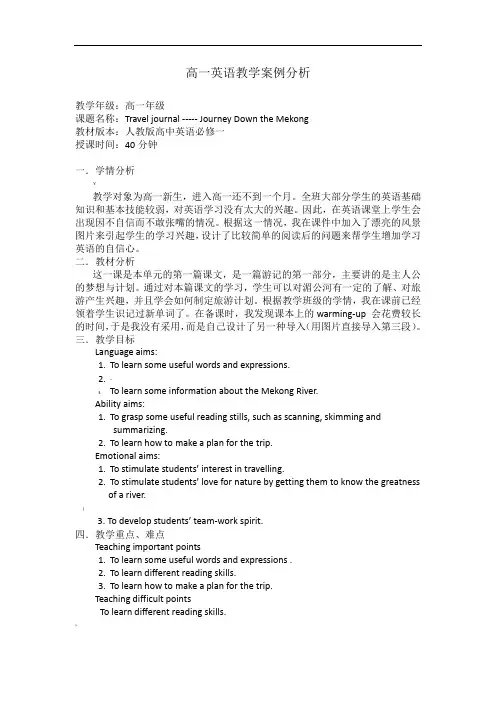
高一英语教学案例分析教学年级:高一年级课题名称:Travel journal ----- Journey Down the Mekong教材版本:人教版高中英语必修一授课时间:40分钟一.学情分析¥教学对象为高一新生,进入高一还不到一个月。
全班大部分学生的英语基础知识和基本技能较弱,对英语学习没有太大的兴趣。
因此,在英语课堂上学生会出现因不自信而不敢张嘴的情况。
根据这一情况,我在课件中加入了漂亮的风景图片来引起学生的学习兴趣,设计了比较简单的阅读后的问题来帮学生增加学习英语的自信心。
二.教材分析这一课是本单元的第一篇课文,是一篇游记的第一部分,主要讲的是主人公的梦想与计划。
通过对本篇课文的学习,学生可以对湄公河有一定的了解、对旅游产生兴趣,并且学会如何制定旅游计划。
根据教学班级的学情,我在课前已经领着学生识记过新单词了。
在备课时,我发现课本上的warming-up 会花费较长的时间,于是我没有采用,而是自己设计了另一种导入(用图片直接导入第三段)。
三.教学目标Language aims:1.To learn some useful words and expressions.2."3.To learn some information about the Mekong River.Ability aims:1.To grasp some useful reading stills, such as scanning, skimming andsummarizing.2.To learn how to make a plan for the trip.Emotional aims:1.To stimulate students’ interest in travelling.2.To stimula te students’ love for nature by ge tting them to know the greatnessof a river.|3. To develop students’ team-work spirit.四.教学重点、难点Teaching important points1.To learn some useful words and expressions .2.To learn different reading skills.3.To learn how to make a plan for the trip.Teaching difficult pointsTo learn different reading skills.~五.教法Task-based methodDiscussionCooperative learning methods六.教学辅助手段Multimedia and other normal teaching tools.七.教学过程设计Step 1. Lead-in"1. Show some beautiful pictures and have students enjoy the beautiful scenery along the Mekong River.2. Questions: 1> Do you like the beautiful scenery2> Where do you think we can see the beautiful sceneryStep 2. Fast reading1.Ask students to read the title of the passage and read the paragraph 3 andfillin the blanks. Then, check the answers and have students enjoy the pictures again. Now, students know that if they travel along the Mekong River, they can enjoy the beautiful scenery.Qinghai (glacier)Yunnan(valleys)rapidsEnters wide valleys (waterfall)Leaves ChinabrownSoutheast Asia(hills,low valleys and plains)delta seaParagraph 3small_________________clear_____cold______________wide____warm_______________________Fast reading2.Teacher: Mekong River is the longest river in Southeast Asia, in China , it’s【called Lancang River and out of China it’s called Mekong River. So, which countries does the Mekong River flow through3.Ask students to look at the map and list the countries that the Mekong River flows through.Step 3. Careful reading1. Ask students to read the paragraph 1-2 and answer the questions:1> Who will travel in the text2> How are they getting there3> Where are they going)4> What did Wang Wei prepare for the trip5> What didn’t she prepare for the trip2. Check the answers.3. According to the questions, they can draw a conclusion: If we want to have a trip, we should think about people, destination, transportation, preparation.Step 4. Discussing and speakingAsk students to discuss with their partners about the characteristics of Wang Weiand Wang Kun.Wang Wei: stubborn; determined; would not change her mind; adventurous:Wang Kun: careful; well-organizedAccording to the discussion, they can draw a conclusion: If we want to have a trip, we need the people with different characteristics.Step 5. SummaryAccording to fives questions and discussion, they can summarize how to make a plan for a trip.Step 6. Homework:Make a plan for the trip. ( the present continuous tense)1. Where are you going to】2. How are you going to...3. When are you leaving4. What are you going to take with you5. Where are you staying6. How long are you staying in…7. When are you coming back八.教学反思这是本单元的第一篇reading,我在设计的时候进行了新的尝试。
(高一英语教案)新教材高一教案UNIT11(第3课时)-教学教案
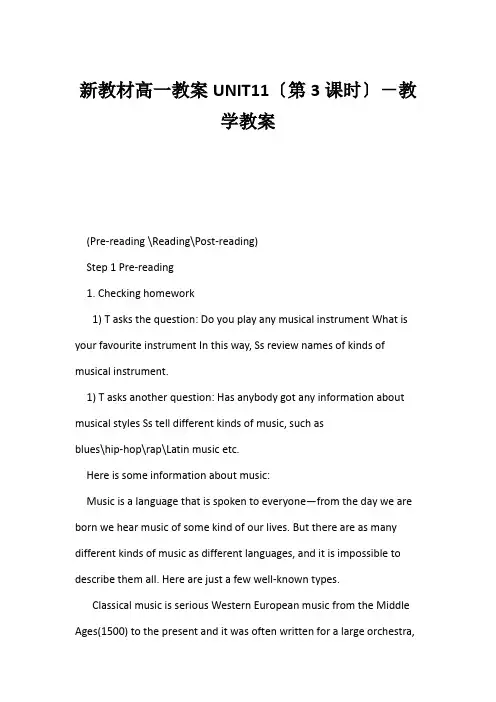
新教材高一教案UNIT11〔第3课时〕-教学教案(Pre-reading \Reading\Post-reading)Step 1 Pre-reading1. Checking homework1) T asks the question: Do you play any musical instrument What is your favourite instrument In this way, Ss review names of kinds of musical instrument.1) T asks another question: Has anybody got any information about musical styles Ss tell different kinds of music, such asblues\hip-hop\rap\Latin music etc.Here is some information about music:Music is a language that is spoken to everyone—from the day we are born we hear music of some kind of our lives. But there are as many different kinds of music as different languages, and it is impossible to describe them all. Here are just a few well-known types.Classical music is serious Western European music from the Middle Ages(1500) to the present and it was often written for a large orchestra,or for a small group of players. Many instruments can be used. A lot of music was also written to be sung as opera. Classical music is very popular and schools often teach this type of music.Jazz developed in the Southern States of North America at the beginning of last century. The black people of these states, who were originally slaves from Africa, had their own rhythms. Jazz brought classical music and African rhythms together.Blues was originally Black Country music, which also came from the Southern States of last century. It is slow, usually sad music, which is often sung by one person with a guitar.Rhythm and blues developed from the Blues in America in the 1940s. It became faster and more complex and used more instruments, e.g. saxophone, guitar, piano, drums. The music was often about city life and white musicians started playing it as well.Musicians in the 1950s developed Rock from Rhythm and Blues and it became popular with young people. It spread to Europe in the 1960s and is now known in most countries. A lot of pop music comes from Rock and Roll.Pop music developed from Rock and Roll in America, Britain and Europe in the 1960s and is now in every country. The name is used for most commercial music, i.e. music we can buy on records and hear on “pop radio〞. It is usually played by groups who often use electricinstruments and make videos to go with their records.2. Pair-workHave Ss discuss these questions in pairs.1) What kind of music do you like2) When you listen to a song, do you listen to words or the music2) Do you like to listen to music form other countries3. A gamePlay some music played by different musical instruments, ask the Ss to guess what makes the song. (piano/guitar/trumpet/drum)Teach the English names of different musical instruments on the slide: violin, trumpet, guitar, jazz drum, mouth-organ, huqin(Chinese violin) etc.Step 2 Reading1. Fasting readingHave Ss read the passage as quickly as possible to find the answer to the question: How many kinds of music are mentioned in the passage and what are they2. Careful readingHave Ss read the passage carefully and fill in the form below according to the passage.。
人教版高中英语教材分析

人教版高中英语教材分析小组成员: 刘倩、李文艳、韩金晶、熊俊娜、宋政目录◆教学目标 (3)高中英语课程目标 (3)◆指导思想 (5)教材体现原则 (6)➢思想性原则 (6)➢科学性原则 (6)➢灵活性原则 (7)➢广泛性原则 (8)➢时代性原则 (8)◆对教与学的指导 (8)◆结构分析 (9)◆教材特点: (13)◆案例分析 (14)◆特点 (16)◆与外研社教材相比,这本教材的特色: (16)教学目标高中英语课程目标指导思想新版教材在编写上,摒弃了以往知识领先的做法,将情感态度、价值观融入课文,旨在使学生通过英语学习,在发展语言能力、思维能力、想象能力和创新能力的同时,逐步树立正确的人生观、世界观和价值观,提高学生的科学文化素养、人文素养及高尚的审美情趣,使学生在心智发展的同时,在情感上也逐渐成熟起来。
新版教材有许多课文渗透着思想情感的教育,对学生的身心发展会产生较强的感染作用,有助于提高他们的素质,扩大他们的国际视野,增强爱国情怀,提高他们对社会的责任感和历史的使命感。
因此,新版教材把培养学生积极向上的情感和态度,作为英语教学的主要任务之一,试图通过大量相关篇章的学习,潜移默化地影响学生的人格,塑造学生的心灵,使他们形成积极向上的情感和活泼开朗的个性,发展与人沟通和合作的能力,增强跨文化理解和跨文化交流的能力。
例如,Unit1 Good friends中Chuck's friend一文,讲述因飞机失事而身困荒岛的Chuck,与他称之为Wilson的排球建立了友谊,让学生懂得“人们在得到关爱的同时,必须给他人同样多的关爱”以及“我们为什么需要互相帮助,我们相互能做些什么”的道理。
再如,Unit14 Festivals中的设定新假日Peace Day,Happiness Day,Friendship Day,Nature Day等,展现了学生心中美好的愿望。
在The Birth of A Festival一文中,我们知道了Kwanzaa(宽扎文化节)的起源及其庆祝方式,并了解了the Seven Principles of Kwanzaa,即人们对新世纪的期盼和美好生活的向往。
高中英语教学反思案例
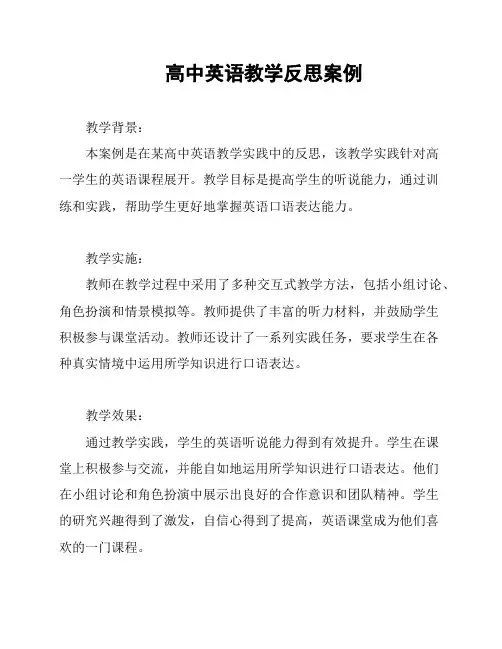
高中英语教学反思案例
教学背景:
本案例是在某高中英语教学实践中的反思,该教学实践针对高
一学生的英语课程展开。
教学目标是提高学生的听说能力,通过训
练和实践,帮助学生更好地掌握英语口语表达能力。
教学实施:
教师在教学过程中采用了多种交互式教学方法,包括小组讨论、角色扮演和情景模拟等。
教师提供了丰富的听力材料,并鼓励学生
积极参与课堂活动。
教师还设计了一系列实践任务,要求学生在各
种真实情境中运用所学知识进行口语表达。
教学效果:
通过教学实践,学生的英语听说能力得到有效提升。
学生在课
堂上积极参与交流,并能自如地运用所学知识进行口语表达。
他们
在小组讨论和角色扮演中展示出良好的合作意识和团队精神。
学生
的研究兴趣得到了激发,自信心得到了提高,英语课堂成为他们喜
欢的一门课程。
反思与改进:
尽管教学实践取得了一定的成效,但仍存在一些问题需要改进。
首先,教师需要更加关注学生个体差异,采用不同的教学策略和方法,以满足不同学生的研究需求。
其次,在教学过程中要更加注重
培养学生的自主研究能力,提供更多的研究资源和指导。
最后,教
师应定期进行教学反馈与评估,及时调整教学策略,以持续改进教
学效果。
结论:
通过这次教学实践的反思,我深刻意识到教师的角色是引导学
生研究的,需要不断适应和改进教学方法。
只有通过反思与改进,
才能不断提高教学的质量和效果,提升学生的研究成绩和研究经验。
新外研版高一英语教案:必修1 Unit 1 1.3 Developing ideas 教学设计(2)- Word版含答案
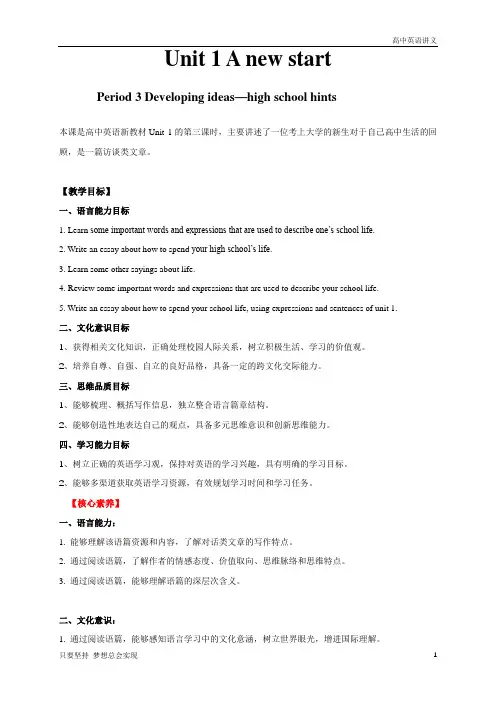
Unit 1 A new startPeriod 3 Developing ideas—high school hints本课是高中英语新教材Unit 1的第三课时,主要讲述了一位考上大学的新生对于自己高中生活的回顾,是一篇访谈类文章。
【教学目标】一、语言能力目标1. Learn some important words and expressions that are used to describe one’s school life.2. Write an essay about how to spend your high school’s life.3. Learn some other sayings about life.4. Review some important words and expressions that are used to describe your school life.5. Write an essay about how to spend your school life, using expressions and sentences of unit 1.二、文化意识目标1、获得相关文化知识,正确处理校园人际关系,树立积极生活、学习的价值观。
2、培养自尊、自强、自立的良好品格,具备一定的跨文化交际能力。
三、思维品质目标1、能够梳理、概括写作信息,独立整合语言篇章结构。
2、能够创造性地表达自己的观点,具备多元思维意识和创新思维能力。
四、学习能力目标1、树立正确的英语学习观,保持对英语的学习兴趣,具有明确的学习目标。
2、能够多渠道获取英语学习资源,有效规划学习时间和学习任务。
【核心素养】一、语言能力:1. 能够理解该语篇资源和内容,了解对话类文章的写作特点。
2. 通过阅读语篇,了解作者的情感态度、价值取向、思维脉络和思维特点。
3. 通过阅读语篇,能够理解语篇的深层次含义。
英语教案设计案例及分析范文
英语教案设计案例及分析范文一、教案设计案例1. 课程名称:英语口语课2. 教学内容及目标:本节课主要围绕日常生活中的购物场景展开,学生将学会询问价格、讨价还价等口语技能。
目标是让学生在实际生活中能够流利自如地应对购物情境。
3. 课时安排:•课前准备(5分钟):师生互动,复习相关购物用语;•导入(10分钟):播放购物场景视频,让学生感受真实情境;•主体教学(25分钟):教师示范询问价格、讨价还价等对话,学生分组练习;•拓展延伸(10分钟):小组讨论其他购物场景,编写对话;•课堂练习(10分钟):学生展示对话,互相评价改进;•课堂总结(5分钟):梳理学习重点,布置作业。
4. 教学方法:•任务型教学,学生参与度高;•多媒体辅助,生动有趣;•小组合作,培养团队合作精神。
二、教学分析1. 教学目标达成性分析通过本节课的教学,学生能够流利运用购物场景所需的口语技能进行对话。
学生在实际生活中遇到购物情境时,能够自信地与对方进行交流,达到了教学目标。
2. 教学方法分析采用任务型教学方法,让学生在实际操作中学习,能够加深学生对知识的理解和记忆。
同时,多媒体辅助能够激发学生学习兴趣,提高学习效果。
小组合作让学生在交流中相互学习,培养了团队意识。
3. 教学进度分析本节课教学进度合理,每个环节间有明确的衔接,学生参与度高,课堂氛围活跃。
学生在短时间内掌握了相关口语技能,课堂效果显著。
4. 教学反思与改进教师应当注意引导学生主动思考和应用所学知识,提高课堂互动;在教学过程中,要及时调整表达方式,以增加学生的理解度;同时,要注意对学生学习情况的反馈,及时调整教学方法和进度,以达到更好的教学效果。
以上是本节课的英语教案设计案例及分析范文,通过规范的执行,能够有效提高学生的口语表达能力,促进他们在实际生活中的应用。
(word完整版)人教版高中英语必修一Unit1教案.doc
Unit 1 FriendshipWarming up1.be good tobe good for=do good tobe good at2.following adj. 下面的,下列的the following+n.=the+n.+below ( 形容词修饰名词放在名词之前,介词或者介词短语修饰名词置于其后)3. add v. add...to...add toadd upadd up toaddition n.in addition=besides +句子in addition to +n./doing 同类用法联想: because & because ofinstead & instead of “而且,其次”“附加给 ..., 除了 ...还有 ...”additional adj. 附加的additionally adv.4. 分数 score grade point mark (full marks)5. until6. with 和...一起,附带着,用without 不...within在...内,不出 ...E.g. write with a peneat with hands/ spoon/chopsticks/knife and forkHe left without saying goodbye.He left with the water running.分析: saying 前无名词,则是主语发出 saying 的动作; running 前有 water,因此是 water 发出 running 的动作,而不是句子的主语 he。
翻译练习:(1)他今天去上班没带领带。
Today, he went to work without (wearing) his tie.(2)他在没有其他人帮助的情况下自己完成了作业。
7.pay for payto do sth8. get sb to do sth(make/have/let sb do sth)get sb/sth doneget done get lost/prepared/dressed/involved9.形容词做状语,表示句子主语的特征、属性和状态副词做状语,表示谓语动词的完成方式E.g. He returned home last night, sad and disappointed.He left hurriedly.10. concern n. 担心,忧虑concern about/for/over...E.g. She hasn’ t been seen for four days and there is concern for her safety.That is a big concern.v. 涉及,与 ...有关be concerned withconcerning E.g. He asked several questions concerning the future of the company.翻译练习:不要问女人们涉及她们年龄的问题。
高一英语教学案例分析
高一英语教学案例分析作为一门基础课程的英语学科,英语教学是中学阶段学生必须要学的。
英语不仅是一门语言,更是一种工具和形象化的表达方法,不仅仅是一种凭借语言交流的能力,而且还关系到工作生活和国际交往等多个方面。
英语教学不仅仅要考察考生学习英语的语法和用法,还需要考虑英语对于人才培养的综合要求。
这就要求教师在教学中需要关注学生的语言运用能力,尤其是口语表达,发挥积极性,不断促进学生英语学习的提高。
本文就通过教学案例分析,研究英语教学在高中中的实际操作,以期为广大英语教师提供一些实用的教学经验与启示。
教学内容设计从课程设置和课堂教学两方面入手,折射出英语教学的解题思路和教学方法。
在教学内容设计方面,英语教师应当全方位切入教学,不断创新,促进英语学习的提升。
在课程陈述上,要极力突出实用性,充分利用材料的时代特点和实用性。
可在同一单元中,安排阅读、听力、口语、综合能力练习、达成语言交流目标以及培养学生的跨文化交际意识。
在课堂教学中,要注重双向交流,调动学生的积极性和主动性,因材施教,将教学目标与学生的兴趣、需求和优势相结合。
让学生从各种渠道进行实践和交流,如英语角、英语演讲、听写比赛等。
促进语音、语调、语调等技巧的高速提高以及对语言学习规律的深入理解。
教学案例一、听力部分:针对高一学生英语水平,听力经常成为他们的一大难点。
这就要求教师要特别关注听力教学的排植和方法。
教师可以准备一些短的英语听力,比如小片段,让学生根据听到的计算或得出一些资料,让学生在听和思考的过程中提高英语的听力水平。
同时,对于一些卡片或手创资料,教师可以让学生先用英文描述,再利用听的彩盒判断听写和语言能力。
在听的过程中,一定要注意展会的建议,用标准的语气读出,进一步培养学生的好听力。
二、口语训练部分:口语水平在英语学习中至关重要,虽然有一些学生语言能力很强,但是口语表达却不好。
当学生实际应用语言,会发现英语口语的难度很大,教师需要大量地推行口语训练。
英语教学案例分析
高一英语教学案例分析课题名称:Cultural Relics阅读课教材版本:人教版高中英语必修一、学生分析教学对象为高中一年级学生,智力发展趋于成熟。
他们的认知水平比初中阶段有了进一步的发展,逐步形成用英语获取信息、处理信息、分析问题和解决问题的水平,所以我特别注重提升学生用英语实行思维和表达的水平。
学生已经完成了高中英语第一个模块的学习,逐步习惯了我的教法。
虽然一开始他们觉得与初中教学很不相同(初中老师注重手把手式的语法教学),但经过半个学期后,他们适合得很快,而且还取得一定的进步。
他们会对课文内容提出自己的疑惑和勇于阐述见解,并且从课内知识拓展到课外,通过多种渠道获取学习资源。
不过,本班学生的水平参差不齐,有些差别还相当大。
所以在教学过程中,布置的任务要兼顾各个层次的学生,使他们都有所收获。
二、教材分析这个课是本单元第一个课时。
在上这个节课前并没有让他们理解太多的与课文内容相关的知识,仅仅因为这课出现的人名和地方名比较多,我在课前教他们读了一下。
我在备这个课时,发现它的warming-up 局部会花费比较长的时间,于是我没有采用,而使用了我自己另外准备的引入(仅仅花了 4 到5 分钟的时间),让学生对这课的话题作好心理准备,也为了完成本单元的目标作了铺垫。
我觉得在今后也必须合理使用手中的教材,根据学生水平和教学设计实行整合或增减,让不同层次的学生在课堂上都有所收获。
三、教学目标本课为阅读课型,主要介绍相关俄罗斯遗失琥珀屋的轶事。
通过阅读使学生理解世界文化遗产,学会描绘他们的起源、发展和保护等方面的情况。
教师根据课文内容用不同的形式来让学生自己归纳,提升阅读技能。
因为这课讲述国外文化遗产,学生会感到陌生,为了引起共鸣,所以要把中外文化遗产结合一起讨论。
本课目的要使学生学会如何谈论文化遗产以及最后形成保护文物的意识。
教学内容大致分为以下几个方面:1 、看图片和听录音引入文化遗产这个话题。
2 、从网上下载一些琥珀屋图片并展示给学生看,分辨新旧琥珀屋,给学生以感官上的刺激,而且有利于协助学生对文章的理解。
- 1、下载文档前请自行甄别文档内容的完整性,平台不提供额外的编辑、内容补充、找答案等附加服务。
- 2、"仅部分预览"的文档,不可在线预览部分如存在完整性等问题,可反馈申请退款(可完整预览的文档不适用该条件!)。
- 3、如文档侵犯您的权益,请联系客服反馈,我们会尽快为您处理(人工客服工作时间:9:00-18:30)。
高一英语教学案例分析
教学年级:高一年级
课题名称:Travel journal ----- Journey Down the Mekong
教材版本:人教版高中英语必修一
授课时间:40分钟
一.学情分析
教学对象为高一新生,进入高一还不到一个月。
全班大部分学生的英语基础知识和基本技能较弱,对英语学习没有太大的兴趣。
因此,在英语课堂上学生会出现因不自信而不敢张嘴的情况。
根据这一情况,我在课件中加入了漂亮的风景图片来引起学生的学习兴趣,设计了比较简单的阅读后的问题来帮学生增加学习英语的自信心。
二.教材分析
这一课是本单元的第一篇课文,是一篇游记的第一部分,主要讲的是主人公的梦想与计划。
通过对本篇课文的学习,学生可以对湄公河有一定的了解、对旅游产生兴趣,并且学会如何制定旅游计划。
根据教学班级的学情,我在课前已经领着学生识记过新单词了。
在备课时,我发现课本上的warming-up 会花费较长的时间,于是我没有采用,而是自己设计了另一种导入(用图片直接导入第三段)。
三.教学目标
Language aims:
1.To learn some useful words and expressions.
2.To learn some information about the Mekong River.
Ability aims:
1.To grasp some useful reading stills, such as scanning, skimming and
summarizing.
2.To learn how to make a plan for the trip.
Emotional aims:
1.To stimulate students’ interest in travelling.
2.To stimulate s tudents’ love for nature by ge tting them to know the greatness
of a river.
3. To develop students’ team-work spirit.
四.教学重点、难点
Teaching important points
1.To learn some useful words and expressions .
2.To learn different reading skills.
3.To learn how to make a plan for the trip.
Teaching difficult points
To learn different reading skills.
五.教法
Task-based method
Discussion
Cooperative learning methods
六.教学辅助手段
Multimedia and other normal teaching tools.
七.教学过程设计
Step 1. Lead-in
1. Show some beautiful pictures and have students enjoy the beautiful scenery along the Mekong River.
2. Questions: 1> Do you like the beautiful scenery?
2> Where do you think we can see the beautiful scenery?
Step 2. Fast reading
1.Ask students to read the title of the passage and read the paragraph 3 and fill in the blanks. Then, check the answers and have students enjoy the pictures again. Now, students know that if they travel along the Mekong River, they can enjoy the beautiful scenery.
Qinghai (glacier)
Yunnan(valleys)
rapids
Enters wide valleys (waterfall)
Leaves China
brown
Southeast Asia(hills,
low valleys and plains)
delta sea
Paragraph 3
small
___
___
___________
clear
_____
cold
______________
wide
____
warm
____
_______________
____
Fast reading
2.Teacher: Mekong River is the longest river in Southeast Asia, in China , it’s called Lancang River and out of China it’s called Mekong River. So, which countries does the Mekong River flow through?
3.Ask students to look at the map and list the countries that the Mekong River flows through.
Step 3. Careful reading
1. Ask students to read the paragraph 1-2 and answer the questions:
1> Who will travel in the text?
2> How are they getting there?
3> Where are they going?
4> What did Wang Wei prepare for the trip?
5> What didn’t she prepare for the trip?
2. Check the answers.
3. According to the questions, they can draw a conclusion: If we want to have a trip, we should think about people, destination, transportation, preparation.
Step 4. Discussing and speaking
Ask students to discuss with their partners about the characteristics of Wang Wei and Wang Kun.
Wang Wei: stubborn; determined; would not change her mind; adventurous
Wang Kun: careful; well-organized
According to the discussion, they can draw a conclusion: If we want to have a trip, we need the people with different characteristics.
Step 5. Summary
According to fives questions and discussion, they can summarize how to make a plan for a trip.
Step 6. Homework:
Make a plan for the trip. ( the present continuous tense)
1. Where are you going to?
2. How are you going to...?
3. When are you leaving?
4. What are you going to take with you?
5. Where are you staying?
6. How long are you staying in…?
7. When are you coming back?
八.教学反思
这是本单元的第一篇reading,我在设计的时候进行了新的尝试。
通过湄公河的风景图片直接导入第三段,带着学生通过快速阅读并填空了解了湄公河沿岸的美景,同时通过多媒体课件中展示的图片让学生有了直观的感受,让学生有了想去旅游的冲动。
接着,我通过五个问题和一个讨论让学生在精读课文回答问题和讨论分析后总结出做旅行计划所要考虑的问题。
最后,布置了家庭作业:制定一个旅行计划,并要求用现在进行时表将来的形式完成,又引出了本单元的语法。
但在教学的实际过程中出现了一些问题:1. 学生还不太适应全英课堂;2. 个人口语水平有限,不能很好地引导学生;3. 每一个环节的过渡不够自然;4. 精读部分练习设计的太少,学生并没有完全了解课文的内容。
在以后的教学中要注意的是,在尝试新想法的同时不能丢了最根本的一些教学方法。
